
(Articles by collectors on how-to, repairs and projects)
 |
|||
| WJ-CEI Home Page | My Publications | Research Material Donations | Bio and Contact |
| Collector Corner (Articles by collectors on how-to, repairs and projects) |
|||
Communication Electronics, Inc |
Bethesda and Rockville, Maryland |
| CEI Main Page | CEI Receivers | CEI History | CEI Related History | CEI Documents |
| CEI-WJ receivers and tuner guide |
CEI-WJ surveillance system guide |
CEI-WJ spectrum display guide |
WJ- CEI Receivers |
CEI and WJ RS-111 Receiver Series |
| Watergate RS-111 | RS-111 flip up SM | RS-111 "steel box" tuner | RS-111 inside | RS-111 under SM |
| CEI RS-111-1B-7 data sheet | CEI RS-111-1B-12 data sheet | WJ RS-111-1B-12B data sheet | ||
Used in the Watergate wiretapping |
|
The RS-111 was manufactured for many years and in many configurations. It continued to be produced with the Watkins Johnson label after they acquired CEI. Details on some of the variants can be found in my CEI-WJ receiver and tuner guide. The unit pictured above is an RS-111-1B-7 made in the Rockville, MD plant. The RS-111 is probably the most successful product ever designed by Communication Electronics Inc. It came to a level of public prominence rare for a spy radio during the televised Watergate hearings when it was displayed before Senate hearings as the receiver used by Nixon's "plumbers" to monitor bugs and wiretaps placed in the Democratic National Committee offices. The photo below shows an RS-111 perched vertically on a table in the Senate Select Hearings investigating the Watergate break-in. The transmitting bug is in James McCord's hand. (Photo from the Washington Star). The bug was manufactured by Bell & Howell Communications of Burlington, MA. |
|
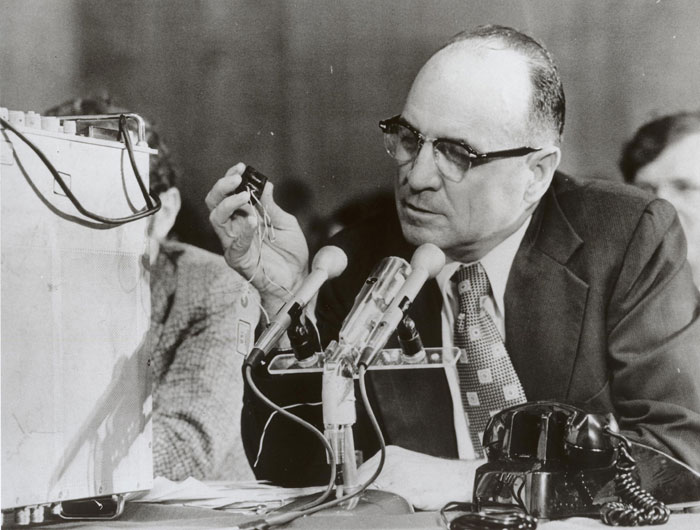 |
|
This is the actual Watergate receiver tagged as evidence by the FBI. (Photo from the Washington Post) Notice the name plate has been removed. The width of the screw holes are the proper size for a Communication Electronics, Inc name plate. The radio was sold to McCord when CEI was owned by WJ, but it was an older CEI receiver. The small toggle switch just to the right of the spectrum display is for the center marker and indicates the radio is an RS-111-1B-12 or later version. |
|
| The RS-111 is a beautiful example of miniaturization for 1963, the year it was introduced. The mechancial design was done by engineer William Bruff. It was his first project for CEI. No other radio combined the frequency coverage, selection of bandwidths and spectrum monitor in package this small. The radio was enormously popular and well over a thousand were manufactured during its 17 year production run. William Bruff rose through the ranks to eventually become a respected and successful vice president of Watkins-Johnson | |
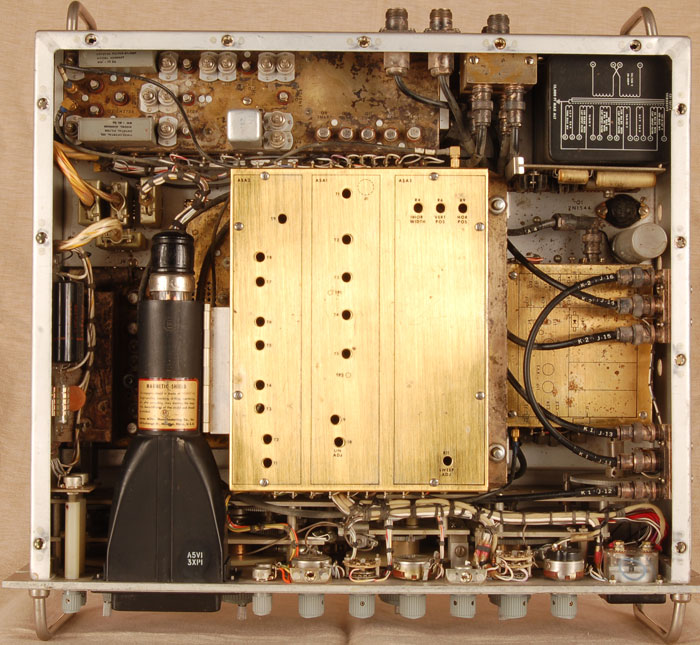 |
|
|
Gold plated subchassis are used throughout. The design and construction are beautifully executed resulting in a radio that is relatively easy to service despite the density inside the chassis. The tuners are all vacuum tube while the IFs, detectors, audio, spectrum monitor and power supply stages are all solid-state. The use of tubes in the tuners was a deliberate choice by founder and designer Ralph Grimm. He did not believe the transistors available in the early 1960s were adequate for serious RF designs. |
|
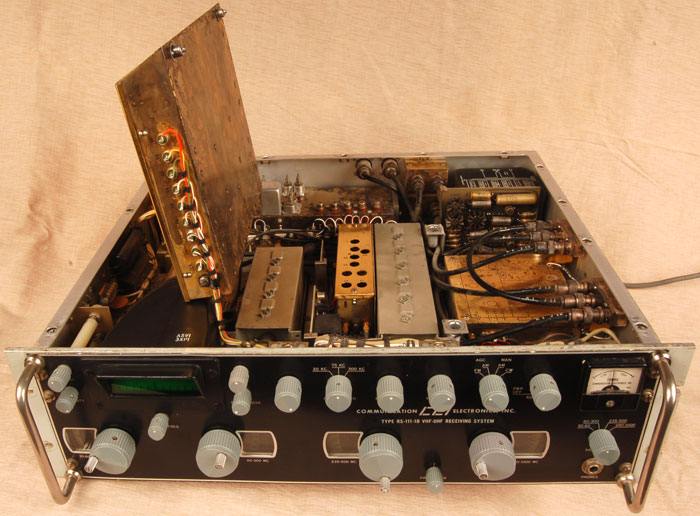 |
|
|
The electronics for the spectrum monitor hinge upward from the side of the tube to provide access to the tuners underneath. The spectrum monitor circuitry was completely updated with the introduction of the RS-111-1B-12. The early units, without the center marker (no toggle switch to the right of the display), have a 3XP1 tube (clearly marked on the mu metal shield). The later units use the 3ASP1 tube. The electronics are not interchangeable |
|
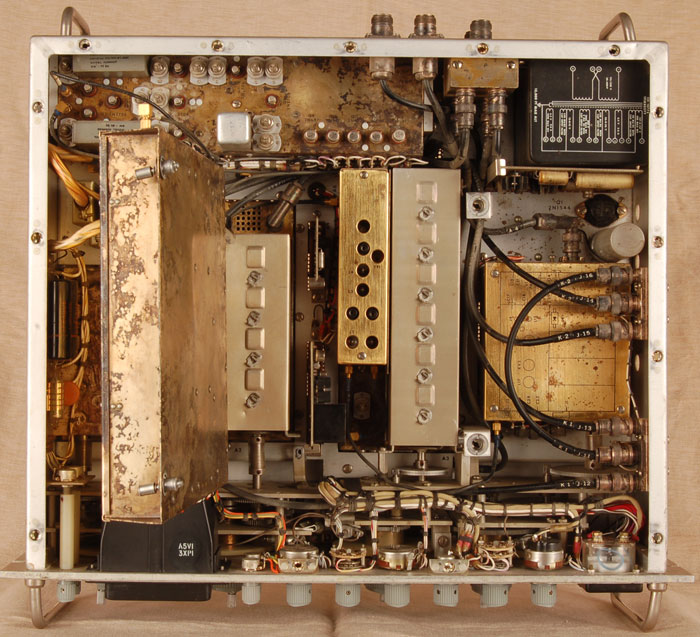 |
|
|
The inside of the radio is tight, but everything is accessible. Everything inside this radio was made in house, the chassis, the subassemblies, the gear trains, even the black transformer in the upper right corner. The three tuners (from lower left, starting under the upraised scope subassembly) for 30-60 MHz, 60-300 MHz and 235-500 MHz use Mallory inductuners as the tuning elements. The tuner on the lower right for 500-1000 MHz was designed by Peter Pao. CEI and WJ employees refered to it as the the "steel box" tuner (picture below). The 500-1000 MHz "steel box" tuner is an evolution of a design Peter Pao developed years earlier while working for CEI founder Ralph Grimm at Nems-Clarke. Similar tuners can be found in several Nems-Clarke radios. Mr. Pao also designed the UHF tuners in Astro Communication Laboratory receivers, which are solid-state versions of this same design. Mr. Pao left CEI with several other employees to found ACL. He eventually returned to CEI and stayed with Watkins-Johnson rising to be a respected and successful vice-president. |
|
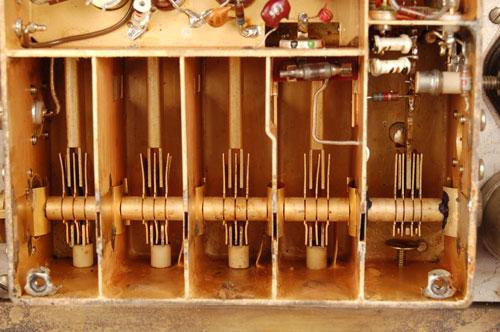 |
The "steel box" tuner is very tricky to align for proper tracking of the four preselector sections and the local oscillator. Senior Test Technician Jack Howard was the only employee to master the construction and alignment of these tuners. He developed jigs that allowed the production staff to accurately assemble the hand built variable capacitor and transmission line assemblies. Mr. Howard also trained several technicians in the almost black art of aligning these tuners. So, a word of caution: When servicing these units, be careful not to bend any of the many plates and tabs on the variable capacitor or the stubs for the transmission lines. |
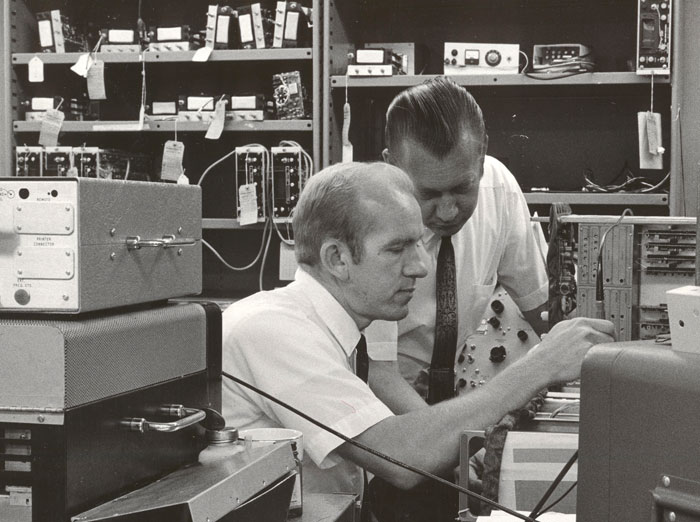 |
|
| Senior Test Technician Jack Howard and Engineer Archie Fosdick in the Watkins-Johnson Quality Assurance shop at the former 6006 Executive Blvd. facility in Rockville, Maryland. Archie Fosdick passed away two months after I interviewed him. | |
.